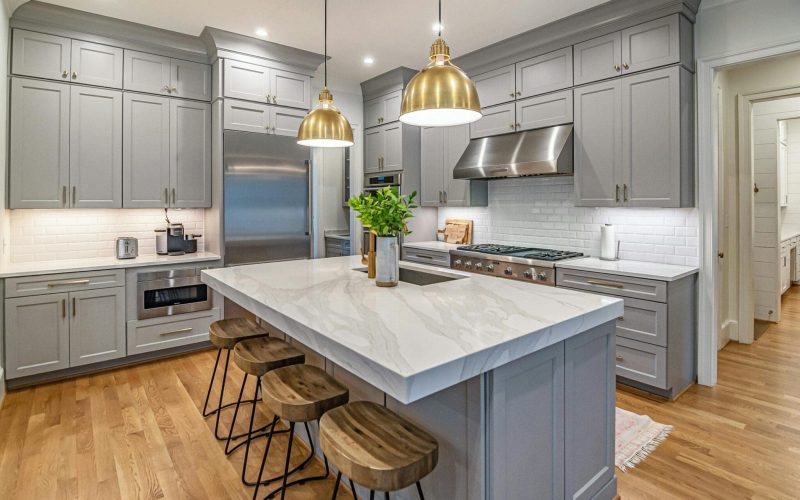If your kitchen is starting to feel like a relic from a bygone decade—or worse, like it belongs in a “before” shot from a home improvement show—it might be time for a remodel. But here’s the thing: not all kitchen remodels are created equal. What works for a family of five might not suit an empty nester, and what looks amazing on Pinterest might be a nightmare for your budget or layout.
In this guide, we’re breaking down how to choose the right kitchen remodel for your lifestyle, space, and budget. Plus, we’ll explain why bringing in the pros isn’t just a good idea—it’s often the smartest, most cost-effective move you can make.
Why Remodel Your Kitchen? (Besides the Obvious Reason)
Sure, you want your kitchen to look better. But kitchen remodels also pack a serious punch when it comes to return on investment. While the exact numbers vary based on the scope of the project and your location, kitchen remodels consistently rank among the top home improvements that boost property value and appeal to future buyers.
Other good reasons to remodel include:
- Increasing your home’s marketability and value
- Improving energy efficiency with modern appliances
- Enhancing functionality, flow, and storage
- Replacing outdated or worn-out materials
- Making the space safer and easier to maintain
Well-executed kitchen upgrades, especially those that balance style with practicality, tend to hold their value better over time. Even minor updates can make a big impact when done right.
Types of Kitchen Remodels: Which One Fits You Best?
Not every kitchen needs to be gutted. Here’s a breakdown of the most common remodel types so you can figure out which one fits your goals (and your wallet).
| Remodel Type | Average Cost (2024) | Typical Scope |
| Cosmetic Update | $5,000 – $20,000 | Paint, fixtures, cabinet hardware, backsplash |
| Minor Remodel | $15,000 – $30,000 | Replacing appliances, countertops, cabinet refacing |
| Midrange Remodel | $30,000 – $75,000 | New cabinets, countertops, appliances, flooring |
| Major Remodel | $75,000 – $150,000+ | Layout changes, structural work, high-end finishes |
The return on investment tends to be higher for more modest remodels—especially when done by professionals—because they cost less upfront while still making a visual and functional impact.
Key Considerations Before You Start Tearing Out Cabinets
Remodeling your kitchen isn’t just about picking pretty tile. Here’s what you should think about first:
1. Your Lifestyle
Do you cook big family meals? Love to entertain? Need space for kids’ homework? Your lifestyle should shape your remodel.
2. Your Budget
Have a clear number in mind—and add a contingency for unexpected costs (industry pros recommend 10–20%).
3. Your Existing Layout
Changing layouts increases costs. Sticking with the same footprint saves money on plumbing, gas, and electrical.
4. Permits and Codes
Even kitchen remodels often require permits for electrical, plumbing, and structural changes. A licensed contractor can handle this for you.
5. Resale Plans
If you plan to sell within five years, focus on neutral, high-ROI upgrades. Avoid hyper-personalized design choices that could limit buyer appeal.
Kitchen Remodel Styles: Find Your Vibe
Let’s get into the fun part: design styles. Here are a few of the most popular kitchen looks right now.
| Style | Key Features | Works Best For |
| Modern | Clean lines, minimal hardware, flat-panel cabinets | Open floorplans, contemporary homes |
| Farmhouse | Shaker cabinets, apron sinks, rustic wood accents | Older homes, open kitchens |
| Transitional | Mix of classic and modern elements | Families, resale-friendly |
| Industrial | Exposed brick, metal finishes, Edison bulbs | Lofts, city dwellings |
| Coastal | Light, airy colors, natural textures | Beach houses, vacation homes |
Appliances and Fixtures: What’s Worth the Splurge?
Not every part of your kitchen needs to be top-of-the-line, but certain upgrades offer better durability, performance, and long-term value.
Good places to splurge:
- Range and oven (especially if you cook a lot)
- High-quality cabinetry
- Durable countertops (think quartz, granite, or solid surface)
Where you can save:
- Decorative light fixtures
- Backsplash tile
- Basic faucets or drawer pulls
Energy-efficient appliances not only reduce your carbon footprint but can also lower your utility bills over time. According to Energy Star, efficient models can save households up to 30% on energy usage annually.
Why You Should Seriously Consider Hiring a Pro
Yes, DIY is tempting—but kitchen remodels aren’t like repainting a bedroom. Mistakes can be dangerous (think electrical and gas lines) and expensive to fix. And let’s be honest—getting halfway through a renovation and realizing you’re in over your head is no one’s idea of a good time.
Benefits of using a professional remodeler:
- Code compliance and permits handled—no surprise fines or rework
- Design expertise to maximize function and flow
- Accurate cost and timeline estimates (with fewer delays)
- Access to trusted subcontractors and suppliers
- Workmanship warranties and accountability
According to a 2024 HomeAdvisor study, homeowners who hired a licensed contractor reported fewer delays and more accurate budgets than DIYers. That’s peace of mind you can’t really put a price on.
Permit Requirements for Kitchen Remodels
Most homeowners don’t realize how many permits a kitchen remodel can require. Here’s a quick breakdown:
| Work Type | Permit Needed? |
| Electrical upgrades | Yes |
| Plumbing work | Yes |
| New appliance installation | Sometimes |
| Wall removal | Yes |
| Flooring changes | Sometimes |
| Cosmetic updates (paint, hardware) | No |
A licensed contractor will usually handle all of this for you—including scheduling inspections and submitting paperwork.
Realistic Timelines for Kitchen Remodels
Kitchen remodels don’t happen overnight. Be realistic about timelines, especially if you’re living in the home during construction.
| Project Scope | Timeline |
| Cosmetic Update | 1–2 weeks |
| Minor Remodel | 3–6 weeks |
| Midrange Remodel | 6–10 weeks |
| Major Remodel | 3–5 months |
Tip: Always build in extra time for permit reviews, backordered materials, or design changes.
Budgeting Tips for Kitchen Remodels
It’s easy for costs to creep up. Stay on track with these smart budgeting tips:
- Set aside 10–20% contingency for surprises.
- Get multiple estimates to compare.
- Avoid scope creep—stick to the original plan unless absolutely necessary.
- Splurge selectively (think statement light fixture or bold backsplash).
- Consider appliance packages or seasonal sales for better pricing.
According to Fixr.com’s 2024 Remodeling Survey, the national average kitchen remodel cost is $27,500, with most projects falling between $15,000 and $75,000 depending on scope and finishes.
Final Thoughts: Invest in Your Kitchen, Invest in Your Home
A great kitchen remodel doesn’t just boost your home’s value—it transforms how you live every day. And while the DIY route might seem like a budget-friendly adventure, it can easily become a stressful, expensive detour without the right experience or tools.
Working with licensed professionals ensures your kitchen not only looks great but functions safely, meets code, and lasts for years. From permit management to design finesse, the pros are there to make the process smoother, faster, and less risky.
Ready to get started? Give us a call or reach out to us via our website.
Dream big. Plan smart. And don’t be afraid to call in the pros.









